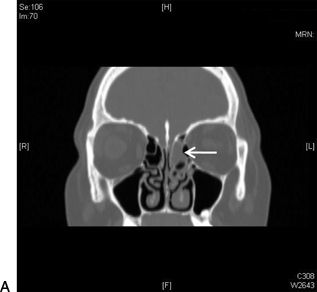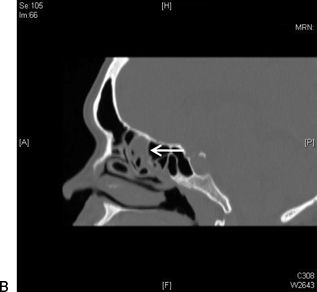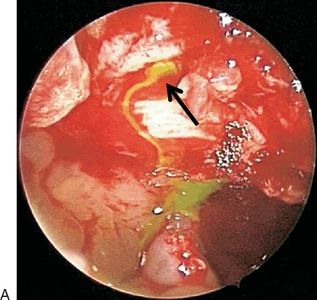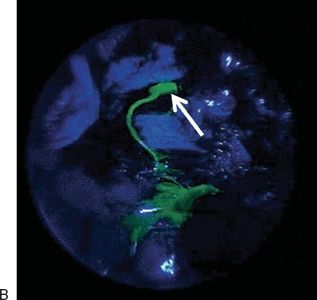Figure 40.1 Zero-degree nasal endoscopic view of the left middle meatus revealing a CSF leak from an encephalocele in the roof of the ethmoid sinus.
INDICATIONS
All dural defects associated with CSF leaks should be surgically closed in order to prevent meningitis or cerebritis, which otherwise will ensue.
CONTRAINDICATIONS
There are relatively few contraindications for this surgical procedure. If a CSF leak is seen in the face of an infection, it may be wise to treat the inflammation or infection prior to the surgery. This is especially seen in patients with spontaneous leaks or when there is evidence of blunt trauma to the head. It is preferable to have stable mucosa that has better potential to heal well postoperatively.
PREOPERATIVE PLANNING
In the preoperative planning of the reconstruction of defects in the skull base, radiologic examinations in the form of a CT scan and MRI scan are absolutely necessary. A CT scan with a triplanar view for image guidance will help in analyzing the defect and also help in the surgical planning. These are usually nonoverlapping axial scans of the head with sagittal and coronal reconstructions (Fig. 40.2). The second imaging modality that should be obtained in all of these cases is an MRI scan with contrast. This helps to identify the extent of brain and meningeal involvement in these defects. They also help to identify important neurovascular structures near the site of the defect. When planning a surgical repair of these defects, the choice of nonvascular material for closure of small defects is usually an autologous homograft. The best choices are a free adipose tissue graft and fascia lata graft, which have the highest potential to heal well. The use of the lumbar drain should be considered in select cases where the potential to obtain a satisfactory result is improved by decreasing intracranial pressure for a short period of time. This is usually the case in spontaneous leaks where the patient’s body mass index is high and associated with high intracranial pressure.


Figure 40.2 Coronal (A) and sagittal (B) CT scan of the sinuses revealing a CSF leak from an encephalocele (arrows) of the left lateral lamellar area and the roof of the ethmoid sinus.
In my experience, the use of intrathecal fluorescein has been a valuable adjunct in identifying the site of the CSF leak in the skull base. Occasionally, there may be multiple leaks that may be overlooked when there is one particular site that is large. This is usually seen in congenital, small skull base bone defects. Fluorescein is injected after a lumbar puncture at the beginning of the surgical procedure. Patients are usually pretreated with diphenhydramine and dexamethasone upon arrival to the operating room, prior to induction of anesthesia. The dosage of fluorescein is usually 0.25 mL of 10% fluorescein diluted in 10 mL of CSF. The use of blue light with or without an amber blocking filter is also helpful in certain cases (Fig. 40.3). It should be noted that this use of fluorescein is off-label. I usually favor a team approach with a neurosurgeon for the closure of these defects, as it is helpful in the entire management of the patient and improves the outcome.






